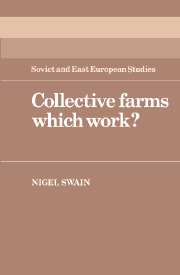Book contents
- Frontmatter
- Contents
- Preface
- Introduction
- PART I ‘FAMILY LABOUR’ AND ‘SOCIALIST WAGE LABOUR’ IN HUNGARY'S CO-OPERATIVE AGRICULTURE: THE INCORPORATION OF PETTY COMMODITY PRODUCTION
- PART II MEMBERS AND MANAGERS
- PART III MANAGERIAL CONTROL IN AGRICULTURE
- 5 Co-operative management's autonomy
- 6 The exercise of managerial control in agriculture
- Conclusion
- Appendix I The transformation of Hungarian agriculture
- Appendix II Ancillary enterprises within agricultural co-operatives: number of units engaged in non-agricultural activity
- Notes
- References and bibliography
- Index
6 - The exercise of managerial control in agriculture
Published online by Cambridge University Press: 10 December 2009
- Frontmatter
- Contents
- Preface
- Introduction
- PART I ‘FAMILY LABOUR’ AND ‘SOCIALIST WAGE LABOUR’ IN HUNGARY'S CO-OPERATIVE AGRICULTURE: THE INCORPORATION OF PETTY COMMODITY PRODUCTION
- PART II MEMBERS AND MANAGERS
- PART III MANAGERIAL CONTROL IN AGRICULTURE
- 5 Co-operative management's autonomy
- 6 The exercise of managerial control in agriculture
- Conclusion
- Appendix I The transformation of Hungarian agriculture
- Appendix II Ancillary enterprises within agricultural co-operatives: number of units engaged in non-agricultural activity
- Notes
- References and bibliography
- Index
Summary
The greater part of this chapter will examine what management actually does with the powers of control which we have seen it possess. But before we do this and go on to consider whether management has a group interest which it might be expected to pursue, it will be instructive to consider the issue of Complex Brigades as an illustration of the keenness of management's defence of its managerial prerogative. The extension in the 1980s to the state industrial sector of sub-contracting ‘economic work partnerships’ was accompanied in agriculture by a revival of forms of decentralised, sub-contracting work groups. Management's success in doing away with Complex Brigades in the politically less reformist 1970s nevertheless reveals how acutely sensitive it was to threats to its right to manage; and the evidence suggests that the current emphasis on decentralisation focuses very much more on increasing the effective autonomy of lower and middle management than on extending workplace democracy, which figures as a secondary, although desirable, aim (Magyar Mezőgazdaság, 1984, No. 6, p. 3).
Complex Brigades were first formed in 1964 on the Szekszárd state farm (Kunszabó, 1972, p. 260). They were based on new experiments in the Ukraine with the ‘link system’ (Juhász and Párkányi, 1977, p. 279), but this was a rather different form of ‘link system’ from that of the 1930s and 1940s (Pospielovsky, 1970) and it is perhaps better, if more clumsily, termed autonomous multi-purpose work teams operating on a profit and loss basis (Nove, 1980, p. 145; Zotova and Novikov, 1969, pp. 211–15). These were introduced in 1961, comprising 15-20 individuals, and were equipped with a full complement of machinery (Pospielovsky, 1970, p. 417). After their introduction in the Ukraine output increased threefold.
- Type
- Chapter
- Information
- Collective Farms which Work? , pp. 162 - 180Publisher: Cambridge University PressPrint publication year: 1985



